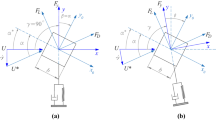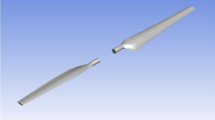Abstract
The galloping of tall structures excited by steady and unsteady wind may be periodic or quasiperiodic (QP) with amplitudes having the same order of magnitude. While the onset of periodic and QP galloping was studied, their control on the other hand has received less attention. In this paper, we conduct analytical study on the effect of a fast harmonic excitation on the onset of periodic and QP galloping in the presence of steady and unsteady wind. We consider the cases where the unsteady wind activates either external excitation, parametric one or both. A perturbation analysis is performed to obtain close expressions of QP solution and the corresponding modulation envelopes. We show that at various loading situations, the periodic and QP galloping onset is significantly influenced by the amplitude of the fast external excitation. In the case where the unsteady wind activates parametric excitation, the QP galloping occurs with higher frequency modulation compared to the case where the unsteady wind activates external excitation. In the case where external and parametric excitations are activated simultaneously, fast harmonic excitation eliminates bistability in the amplitude response and gives rise to a new small QP modulation envelope.






















Similar content being viewed by others
References
Parkinson, G.V., Smith, J.D.: The square prism as an aeroelastic non-linear oscillator. Q. J. Mech. Appl. Math. 17, 225–239 (1964)
Novak, M.: Aeroelastic galloping of prismatic bodies. J. Eng. Mech. Div. 96, 115–142 (1969)
Nayfeh, A.H., Abdel-Rohman, M.: Galloping of squared cantilever beams by the method of multiple scales. J. Sound Vib. 143, 87–93 (1990)
Abdel-Rohman, M.: Effect of unsteady wind flow on galloping of tall prismatic structures. Nonlinear Dyn. 26, 231–252 (2001)
Clark, R., Modern, A.: Course in Aeroelasticity, 4th edn. Kluwer Academic, Dordrecht (2004)
Spencer, B.F. Jr., Nagarajaiah, S.: State of the art of structural control. J. Struct. Eng. 129, 845–865 (2003)
Luongo, A., Zulli, D.: Parametric, external and self-excitation of a tower under turbulent wind flow. J. Sound Vib. 330, 3057–3069 (2011)
Tondl, A.: On the interaction between self-excited and parametric vibrations. National Research Institute for Machine Design, Monographs and Memoranda No. 25, Prague (1978)
Schmidt, G.: Interaction of self-excited forced and parametrically excited vibrations. In: The 9th International Conference on Nonlinear Oscillations. Application of the Theory of Nonlinear Oscillations, vol. 3. Naukowa Dumka, Kiev (1984)
Szabelski, K., Warminski, J.: Self excited system vibrations with parametric and external excitations. J. Sound Vib. 187(4), 595–607 (1995)
Belhaq, M., Fahsi, A.: Higher-order approximation of subharmonics close to strong resonances in the forced oscillators. Comput. Math. Appl. 33(8), 133–144 (1997)
Guckenheimer, J., Holmes, P.: Nonlinear Oscillations, Dynamical Systems, and Bifurcations of Vector Fields. Springer, New York (1983)
Nayfeh, A.H., Balachandran, B.: Applied Nonlinear Dynamics: Analytical, Computational, and Experimental Methods. Wiley, New York (1995)
Belhaq, M., Fahsi, A.: Analytics of heteroclinic bifurcation in a 3:1 subharmonic resonance. Nonlinear Dyn. 62, 1001–1008 (2010)
Fahsi, A., Belhaq, M.: Analytical approximation of heteroclinic bifurcation in a 1:4 resonance. Int. J. Bifurc. Chaos Appl. Sci. Eng. 22, 1250294 (2012)
Qu, W.L., Chen, Z.H., Xu, Y.L.: Dynamic analysis of a wind-excited stress tower with friction dampers. Comput. Struct. 79, 2817–2831 (2001)
Kirrou, I., Mokni, L., Belhaq, M.: On the quasiperiodic galloping of a wind-excited tower. J. Sound Vib. 32, 4059–4066 (2013)
Belhaq, M., Fahsi, A.: Hysteresis suppression for primary and subharmonic 3:1 resonances using fast excitation. Nonlinear Dyn. 57, 275–286 (2009)
Hamdi, M., Belhaq, M.: Quasi-periodic oscillation envelopes and frequency locking in rapidly vibrated nonlinear systems with time delay. Nonlinear Dyn. 73, 1–15 (2013)
Blekhman, I.I.: Vibrational Mechanics—Nonlinear Dynamic Effects, General Approach, Application. World Scientific, Singapore (2000)
Thomsen, J.J.: Vibrations and Stability: Advanced Theory, Analysis, and Tools. Springer, Berlin (2003)
Lakrad, F., Belhaq, M.: Suppression of pull-in instability in MEMS using a high-frequency actuation. Commun. Nonlinear Sci. Numer. Simul. 15, 3640–3646 (2010)
Nayfeh, A.H., Mook, D.T.: Nonlinear Oscillations. Wiley, New York (1979)
Zulli, D., Luongo, A.: Bifurcation and stability of a two-tower system under wind-induced parametric, external and self-excitation. J. Sound Vib. 331, 365–383 (2012)
Keightley, W.O., Housner, G.W., Hudson, D.E.: Vibration tests of the Encino dam intake tower. California Institute of Technology, Report No. 2163, Pasadena, California (1961)
Belhaq, M., Houssni, M.: Quasi-periodic oscillations, chaos and suppression of chaos in a nonlinear oscillator driven by parametric and external excitations. Nonlinear Dyn. 18, 1–24 (1999)
Rand, R.H., Guennoun, K., Belhaq, M.: 2:2:1 resonance in the quasi-periodic Mathieu equation. Nonlinear Dyn. 31, 187–193 (2003)
Author information
Authors and Affiliations
Corresponding author
Appendices
Appendix A
The expressions of the coefficients of Eq. (1) are
where ℓ is the height of the tower, b is the cross-section wide, EI the total stiffness of the single story, m is the mass longitudinal density, h is the interstory height, and ρ is the air mass density. A i ,i=0,…,3 are the aerodynamic coefficients for the squared cross-section. The dimensional critical velocity is given by
Here, ξ is the modal damping ratio, depending on both the external and internal damping
The following numerical values picked from [7] are used for convenience: the height of the tower is ℓ=36 m, the cross-section is b=16 m wide, the total stiffness of the single story is EI=115318000 N m2, the mass longitudinal density is m=4737 kg/m, the damping ratio is ζ=0.5 percent (corresponding to η=128513 N s, c=34.8675 N s/m2 in Eq. (25)). The interstory height is assumed h=4m. The aerodynamic coefficients A i ,i=0,…,3 are taken from [4] for the squared cross-section: A 0=0.0297, A 1=0.9298, A 2=−0.2400, A 3=−7.6770. The air mass density is ρ=1.25 kg/m3. The (dimensional) natural frequency of the rod is ω=5.89 rad/s. The (dimensional) critical wind velocity assumes the value \(\overline{U}_{c}=30~\mbox{m/s}\).
Appendix B
Introducing \(D_{i}^{j}\equiv\frac{\partial^{j}}{\partial ^{j}T_{i}}\) yields \(\frac{d}{dt}=\nu D_{0}+ D_{1}\), \(\frac{d^{2}}{dt^{2}}=\nu^{2} D_{0}^{2}+ 2\nu D_{0}D_{1}+D_{1}^{2}\) and substituting Eq. (2) into Eq. (1) gives
Averaging (26) leads to
Subtracting (27) from (26) yields
Using the inertial approximation [20], i.e., all terms in the left-hand side of Eq. (28), except the first, are ignored, one obtains
Inserting ϕ into Eq. (27), using that 〈cos2 T 0〉=1/2, and keeping only terms of orders three in z, give the equation governing the slow dynamic of the motion (3).
Rights and permissions
About this article
Cite this article
Belhaq, M., Kirrou, I. & Mokni, L. Periodic and quasiperiodic galloping of a wind-excited tower under external excitation. Nonlinear Dyn 74, 849–867 (2013). https://doi.org/10.1007/s11071-013-1010-9
Received:
Accepted:
Published:
Issue Date:
DOI: https://doi.org/10.1007/s11071-013-1010-9




